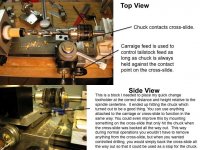That sounds like another way to keep the bit from being pulled in, and I do something similar when drilling for weight bolts, only I use the tool post to help support the extra long drill that I use... I usually use the resistance as Bill mentioned when I have to use a drill, and have that issue of the drill being sucked in, usually only a problem with larger drills though, and As Arnot mentioned I prefer to use a boring bar, especially when making a larger hole for a plug or something of that nature, but I use them for smaller sizes too when I don't have a reamer in the size that I need.. I do use reamers for pin installations sometimes, and have good results with the ones that I have sized correctly for whatever pin I install. They also do not get sucked in the same way a drill does, and the ones that I use are pretty darn accurate, so My results are very close to the same as with a boring bar. It just makes the job a little bit faster without changing the tooling on My carriage. The main goal is accuracy, so as long as I am achieving that then I'm satisfied, and I under drill the hole a little before reaming so that It almost acts similar to a boring bar. I start the hole with center drill, and run It in until the bevel is sized at about the same size as the final hole made with the reamer will be. when I under drill with the drill bit the lead part of the hole is still accurate even if the drill did not go in perfect, and that lead part of the hole is what I use to start the reamer on, so the under drilled hole has no bearing on whether or not the reamer goes in straight. It just removes some of the material. As long as My inside champer is still there after under-drilling, and is accurate where the reamer starts out, Then It usually carries through. I guess It's similar to how some people use a pilot to start out when using a gun drill.
